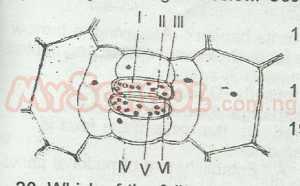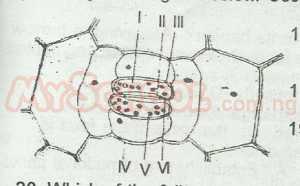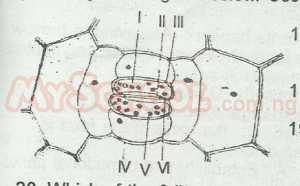The neurone that relay the message of effector organs are called
- A. efferent neurones
- B. intermediate neurones
- C. afferent neurones
- D. spinal nerves
The nerves that arise from the brain are known as
- A. spinal nerves
- B. sacral nerves
- C. cranial nerves
- D. optic nerves
Which of the following is responsible for the increased heart beat of a boy who saw a python? increased
production of
- A. adrenalin
- B. insulin
- C. pituitrin
- D. thyroxin
The organs constantly in touch with the liver are
- A. pancreas, colon and caecum
- B. duodenum and stomach
- C. illeum, stomach and colon
- D. stomach and gall bladder
Which of the following conditions will cause a decrease in body temperature?
- A. increased metabolism
- B. Shivering
- C. Vasoconstriction of capillaries of the skin
- D. Relaxation of the erector muscles

Which of the following solutions will induce the condition shown in the diagram?
- A. Hypertonic solution
- B. Hypotonic solution
- C. isotonic solution
- D. Distilled water.

The condition shown in the above diagram is due to
- A. conversion of starch to sugar
- B. conversion of sugar to starch
- C. excess water in structure labelled I
- D. presence of carbondioxide in the structure labelled I

Which of the labelled structures in the diagram will shrink when plasmolysis
occurs?
- A. I
- B. II
- C. III
- D. IV

Which of the labelled structures in the diagram are involved with the entry
of carbondioxide for photosynthesis?
- A. I, II and III only
- B. I, II, III and VI
- C. I, II, V and VI
- D. I, II, III, and IV
When a mammal respires anaerobically for a long time
- A. pyruvic acid is convened into acetyl COA
- B. more energy is released from fats in the body
- C. lactic acid accumulates in the muscles
- D. the Krebs cycle is fully completed.
Which of the following structures is not present in the vascular bundles of a dicot stem?
- A. Xylem
- B. Phloem
- C. lntra-fascicular cambium
- D. Inter-fascicular cambium
The following are useful effect of micro-organisms except
- A. production of vaccines
- B. curing of tobacco
- C. tanning of leather
- D. decay of meat
Which of the following plant parts does not perform supportive function?
- A. Parenchyma, xylem and . collenchyma
- B. Epidermis, sclerenchyma and xylem
- C. Parenchyma, collenchyma and sclerenchyma
- D. Sclerenchyma, xylem and collenchyma
Which of the following organisms has the largest surface area-to-volume ratio?
- A. Man
- B. Earthworm
- C. Amoeba
- D. Grasshopper
The following are the functions of supporting tissues in plant except
- A. rigidity
- B. flexibility
- C. strengthening
- D. secretory
In which of the following organisms is ammonia excreted as a waste product?
- A. Man
- B. Bird
- C. Amoeba
- D. Spirogyra
Which of the following statements is incorrect about diffusion?
- A. It involves degradation of soluble particles in solvents
- B. it occurs mainly in gaseous and liquid media
- C. No membrane is needed to effect the movement of molecules
- D. Molecules move from region of lower concentration to that of higher concentration.
The presence of a large member of mitochondria in a cell indicates that
- A. it has little cytoplasmic content
- B. the cell is very active
- C. the cell is dormant
- D. the respiration is poor
The plant cell mostly stores food as
- A. glycogen
- B. auxins
- C. homtones
- D. starch
The unit contained in a cell structure responsible for changes in form and shape of organisms is called
- A. mitochondria
- B. gene
- C. ribosome
- D. lysosome
Which of these has the most complex level of organization?
- A. Euglena
- B. Hydra
- C. Heart
- D. Virus


